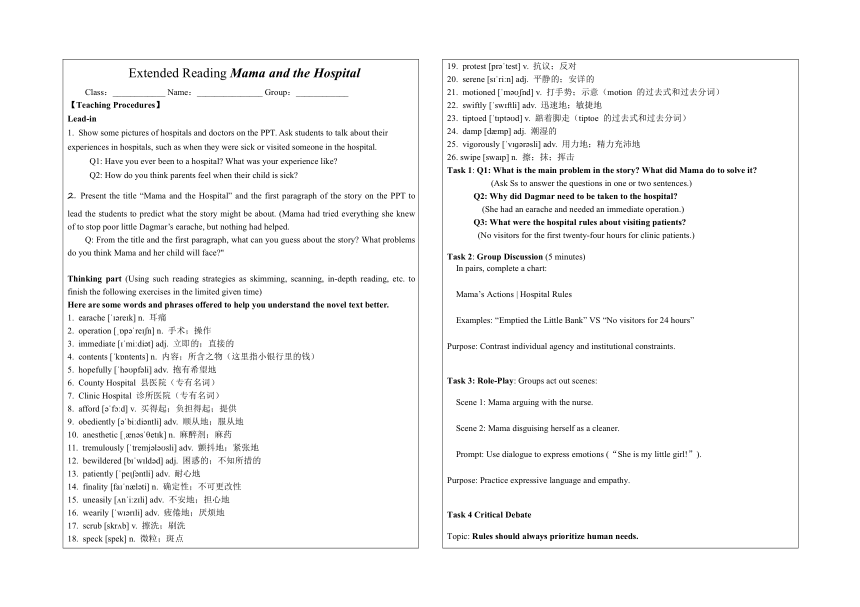Unit 2 Let’s talk teens Extended reading 导学案(无答案)-2024-2025学年高中英语译林版(2020)必修第一册
文档属性
| 名称 | Unit 2 Let’s talk teens Extended reading 导学案(无答案)-2024-2025学年高中英语译林版(2020)必修第一册 |  | |
| 格式 | docx | ||
| 文件大小 | 21.0KB | ||
| 资源类型 | 教案 | ||
| 版本资源 | 牛津译林版(2019) | ||
| 科目 | 英语 | ||
| 更新时间 | 2025-03-02 16:11:29 | ||
图片预览

文档简介
Extended Reading Mama and the Hospital Class:____________ Name:_______________ Group:____________ 【Teaching Procedures】 Lead-in Show some pictures of hospitals and doctors on the PPT. Ask students to talk about their experiences in hospitals, such as when they were sick or visited someone in the hospital. Q1: Have you ever been to a hospital What was your experience like Q2: How do you think parents feel when their child is sick Present the title “Mama and the Hospital” and the first paragraph of the story on the PPT to lead the students to predict what the story might be about. (Mama had tried everything she knew of to stop poor little Dagmar’s earache, but nothing had helped. Q: From the title and the first paragraph, what can you guess about the story What problems do you think Mama and her child will face " Thinking part (Using such reading strategies as skimming, scanning, in-depth reading, etc. to finish the following exercises in the limited given time) Here are some words and phrases offered to help you understand the novel text better. earache [ re k] n. 耳痛 operation [ p re n] n. 手术;操作 immediate [ mi di t] adj. 立即的;直接的 contents [ k ntents] n. 内容;所含之物(这里指小银行里的钱) hopefully [ h pf li] adv. 抱有希望地 County Hospital 县医院(专有名词) Clinic Hospital 诊所医院(专有名词) afford [ f d] v. 买得起;负担得起;提供 obediently [ bi di ntli] adv. 顺从地;服从地 anesthetic [ n s θet k] n. 麻醉剂;麻药 tremulously [ tremj l sli] adv. 颤抖地;紧张地 bewildered [b w ld d] adj. 困惑的;不知所措的 patiently [ pe ntli] adv. 耐心地 finality [fa n l ti] n. 确定性;不可更改性 uneasily [ n i z li] adv. 不安地;担心地 wearily [ w r li] adv. 疲倦地;厌烦地 scrub [skr b] v. 擦洗;刷洗 speck [spek] n. 微粒;斑点 protest [pr test] v. 抗议;反对 serene [s ri n] adj. 平静的;安详的 motioned [ m nd] v. 打手势;示意(motion 的过去式和过去分词) swiftly [ sw ftli] adv. 迅速地;敏捷地 tiptoed [ t pt d] v. 踮着脚走(tiptoe 的过去式和过去分词) damp [d mp] adj. 潮湿的 vigorously [ v ɡ r sli] adv. 用力地;精力充沛地 26. swipe [swa p] n. 擦;抹;挥击 Task 1: Q1: What is the main problem in the story What did Mama do to solve it (Ask Ss to answer the questions in one or two sentences.) Q2: Why did Dagmar need to be taken to the hospital (She had an earache and needed an immediate operation.) Q3: What were the hospital rules about visiting patients (No visitors for the first twenty-four hours for clinic patients.) Task 2: Group Discussion (5 minutes) In pairs, complete a chart:
Mama’s Actions | Hospital Rules
Examples: “Emptied the Little Bank” VS “No visitors for 24 hours”
Purpose: Contrast individual agency and institutional constraints.
Task 3: Role-Play: Groups act out scenes:
Scene 1: Mama arguing with the nurse.
Scene 2: Mama disguising herself as a cleaner.
Prompt: Use dialogue to express emotions (“She is my little girl!”).
Purpose: Practice expressive language and empathy.
Task 4 Critical Debate
Topic: Rules should always prioritize human needs.
Task: Split into pro/con groups. Use textual evidence to argue.
Example: “Mama’s love justifies breaking rules” VS. “Rules protect patients.”
Purpose: Foster logical reasoning and persuasive language.
Activity 2: Creative Writing Homework: Task 1: Write a diary from Mama’s perspective after seeing Dagmar.
(Prompt: Include her feelings, fears, and reflections on the hospital.)
Purpose: Deepen emotional and cultural connection to the text.
Task 2: On Cross-Cultural Reflection:
Research healthcare rules in another country (e.g., Japan vs. the U.S.). Compare with the story.
Mama’s Actions | Hospital Rules
Examples: “Emptied the Little Bank” VS “No visitors for 24 hours”
Purpose: Contrast individual agency and institutional constraints.
Task 3: Role-Play: Groups act out scenes:
Scene 1: Mama arguing with the nurse.
Scene 2: Mama disguising herself as a cleaner.
Prompt: Use dialogue to express emotions (“She is my little girl!”).
Purpose: Practice expressive language and empathy.
Task 4 Critical Debate
Topic: Rules should always prioritize human needs.
Task: Split into pro/con groups. Use textual evidence to argue.
Example: “Mama’s love justifies breaking rules” VS. “Rules protect patients.”
Purpose: Foster logical reasoning and persuasive language.
Activity 2: Creative Writing Homework: Task 1: Write a diary from Mama’s perspective after seeing Dagmar.
(Prompt: Include her feelings, fears, and reflections on the hospital.)
Purpose: Deepen emotional and cultural connection to the text.
Task 2: On Cross-Cultural Reflection:
Research healthcare rules in another country (e.g., Japan vs. the U.S.). Compare with the story.
